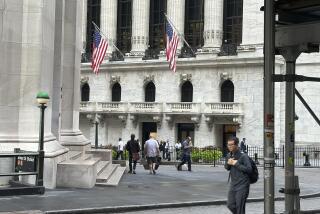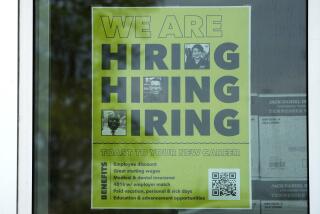U.S. unemployment rate at 7.6%; jobs disappearing at faster pace
Spooked by the deteriorating economy, businesses are continuing to shed jobs at an alarming pace, pushing the unemployment rate to 7.6%, its highest level in 16 years.
The government Friday gave its latest damage report: 598,000 jobs lost in January, the biggest for any single month since 1974.
And job losses for November and December were much worse than previously estimated, the Labor Department said, likely reflecting layoffs at smaller firms that are slower to report their data.
“The recession has deepened and we’re in the worst part of it now,” said Mickey Levy, chief economist at Bank of America in New York.
Many economists expect the job losses to continue for months to come and the unemployment rate to top 9% before improving.
Still, the stock market rallied, with the Dow Jones industrial average rising more than 200 points, as investors looked forward to Monday’s expected announcement on President Obama’s plan for resuscitating the nation’s banks and easing the housing crisis.
Financial stocks led the way up on hopes that Treasury Secretary Timothy F. Geithner will unveil a comprehensive plan that could revive bank lending without having the government nationalize major institutions.
“Any good news -- meaning there’s anticipation of a well-thought-out solution for the financial system -- is welcome,” said Robert W. Bissell, president of Wells Capital Management in Los Angeles.
Investors also viewed the dreary unemployment numbers as ratcheting up pressure on lawmakers to speed the enactment of the long-awaited economic stimulus package.
The Dow rose for the second day in a row, climbing 217.52 points, or 2.7%, to 8,280.59. The Nasdaq composite index turned positive for the year. A widely followed bank-stock index jumped 12%, with some stocks surging more than 30%.
The buying was driven in part by investors closing out bearish bets against the banking sector in advance of Geithner’s announcement.
Shares of Bank of America, which had fallen below $5 this week amid speculation that it could be nationalized, rose $1.29, to $6.13, after Chairman and Chief Executive Kenneth D. Lewis asserted on CNBC that the company wouldn’t require additional capital injections from the government.
Still, investors are wary that the bank-rescue plan won’t be robust enough or implemented quickly enough.
“It’s essential to have this happen [but] the devil is in the details,” said A.C. Moore, chief investment strategist for Dunvegan Associates Inc. in Santa Barbara.
Obama has said he was pursuing a three-pronged attack on the economic crisis. The first part is the $800-billion stimulus plan, which the president is pushing Congress to complete by the end of next week. The second part is the bank stabilization plan, and the third part is a program to stem the tide of home foreclosures that triggered the economic downturn.
On the banking front, the administration is expected to use a combination of measures to shore up the financial system, including insuring some banks against losses, buying up some of their bad assets and sequestering them in a stand-alone “bad bank,” and recapitalizing others.
Simon Johnson, a professor at MIT’s Sloan School of Business, said that to be successful, the Obama administration’s program needed to be simpler and more transparent than the stabilization measures taken by the Bush administration under the unpopular TARP program.
In particular, he said, it will be important to show how assets were valued so taxpayers have some assurance that they are not overpaying, whether the government is buying or insuring the troubled assets.
“Unless you are transparent, you’ll get a massive backlash against the scheme,” Johnson said.
To address the housing crisis, the administration is expected to leverage the size and expertise of Fannie Mae and Freddie Mac -- the mortgage giants now controlled directly by the federal government -- to spur the refinancing of millions of troubled mortgages.
Lee Ohanian, an economist at UCLA, said the recession, which began in December 2007, was relatively mild until the financial crisis worsened in September and businesses lost confidence in the economy. As a result, it is critical that Geithner’s plan restore confidence in the markets, he said. If it does, then Wall Street may be right that recovery is on the way.
“Geithner’s proposal could be a key ingredient in a recovery,” Ohanian said. “The stock market, more than anyone else, understands that we had a perfect storm of bad regulations and bad policies that led to this. And they understand better than anyone else that once we have the financial system addressed, we can start making progress.”
Still, financial markets tend to be forward-looking and to rebound quickly. The labor market, on the other hand, tends to react more slowly, and job losses often continue well after stocks and other financial indicators improve.
Nigel Gault, chief U.S. economist for IHS Global Insight, a forecasting firm in Lexington, Mass., said he wasn’t “as confident as the stock market is that things are gong to get better any time soon.”
The stimulus plan “will make things less bad, but that doesn’t alter the fact that these numbers are bad and the downward momentum is severe,” Gault said. “If we’re bottoming, it’s in the sense that the most severe rates of decline are what we’re experiencing now.”
Since the recession began, the economy has shed 3.6 million jobs, and the losses in the last two months of 2008 were even worse than previously reported. The Labor Department issued a revised tally on Friday indicating that December’s job losses were 577,000, up from an estimated 527,000, and November’s came in at 597,000, up from 584,000.
Heidi Shierholz, an economist with the Democratic-leaning Economic Policy Institute, said that the 3.6-million figure for job losses “far understates the true gap between how many jobs there are today and how many are needed.”
Just to keep up with population growth, Shierholz estimated, the economy should have been adding 127,000 jobs a month. “The economy is now 5.2 million jobs below where it would need to be to have maintained pre-recession rates of employment for the American workforce,” Shierholz said.
Economists also say that the unemployment rate undercounts the number of idled workers. When “marginally attached” workers are included -- those who are too discouraged to look for work and those who have taken part-time jobs because they can’t find full-time work -- January’s unemployment rate comes in at 13.9%. That’s the highest rate since the Labor Department started calculating the “under-employment” rate in 1994.
Levy of BofA noted that the number of hours worked fell sharply in January, dropping 0.7% in the economy as a whole and 2.0% in goods-producing sectors. That means that even workers who haven’t lost their jobs are seeing their hours cut.
“Not only are jobs being shed, but part-time work is being cut and overtime is being cut,” Levy said. “This clearly affects everyone and every sector of the economy. There is no place to hide.”
--
walter.hamilton@latimes.com
--
(BEGIN TEXT OF INFOBOX)
U.S. jobs by sector
Total of job gains and losses from December 2007 through January 2009:
(Jobs in thousands)
Manufacturing: -1,067
Trade, transportation, utlitites: -1,009
Construction: -813
Professional and business services: -778
Retail: -592
Financials: -274
Leisure: -259
Others: -143
Natural resources and government: +244
Education, health services: +624
Source: Labor Department; Graphics reporting by Scott Wilson
More to Read
Inside the business of entertainment
The Wide Shot brings you news, analysis and insights on everything from streaming wars to production — and what it all means for the future.
You may occasionally receive promotional content from the Los Angeles Times.










